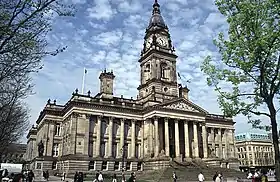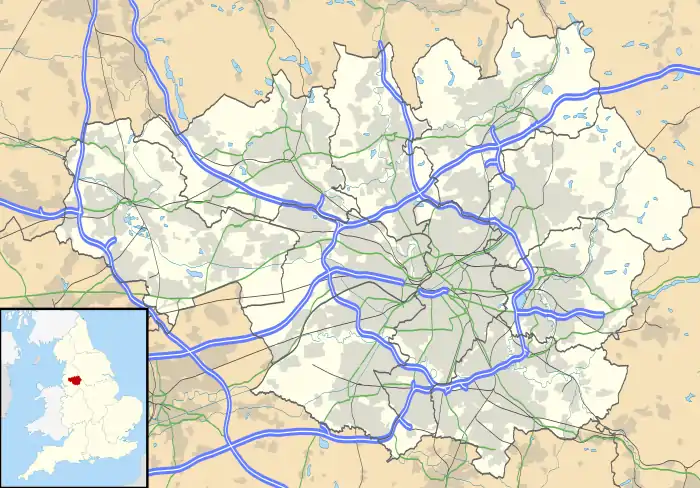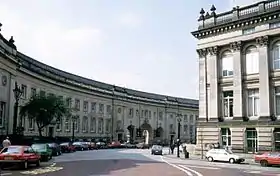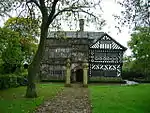Bolton Town Hall
Bolton Town Hall facing Victoria Square in Bolton, Greater Manchester, England, was built between 1866 and 1873 for the County Borough of Bolton to designs by William Hill of Leeds and George Woodhouse of Bolton. The town hall was extended in the 1930s to the designs of Bradshaw, Gass and Hope and has been designated a Grade II* listed building by English Heritage.[1]
| Bolton Town Hall | |
|---|---|
 Bolton Town Hall | |
| Location | Bolton |
| Coordinates | 53.578°N 2.430°W |
| Built | 1866-73 |
| Architect | William Hill |
| Architectural style(s) | Neoclassical style |
Listed Building – Grade II* | |
| Designated | 26 April 1974 |
| Reference no. | 1388295 |
 Shown in Greater Manchester | |
Background
The town hall was promoted by the mayor, J.R. Wolfendon, in the early 1860s. The cost was expected to be between £70000 and £80,000 but more than doubled to £167,000,[2] equivalent to £14,910,000 in 2021.[3] Bolton Corporation held a competition for a new town hall design in the 1860s. It was won by a pupil of Cuthbert Brodrick, architect William Hill from Leeds whose design was very similar to that of the 1858 Leeds Town Hall.[4] It was opened by the Prince of Wales on 4 June 1873.[5] Portsmouth Guildhall, also designed by Hill in 1890, is a similar, slightly larger copy of the town hall.[6]
In the early 1930s the town hall was extended and a crescent of civic buildings was built to the rear on a new street to provide office space. The extension matches the Victorian building externally, but is plain inside and contains offices.[7] The town hall had a central hall lit by a clerestory that was gutted by fire on 14 November 1981. It was rebuilt as two public halls, the Albert Hall and Festival Hall. The halls are surrounded by an outer ring of offices.[8]
The building served as the headquarters of the County Borough of Bolton for much of the 20th century and remained the local seat of government when the enlarged Bolton Council was formed in 1974.[9]
In 1978 Fred Dibnah made repairs to the clock tower and its 16 stone pillars. Whilst repairing the tower he gilded the sphere at the top.[10]
During the cold war, the county standby nuclear bunker was located directly below the town hall. It dates to the second world war and would have been modernised to offer protection from nuclear attack.[11]
Architecture
The original building on a rectangular plan is designed in the neoclassical style in the form of a temple with a tall baroque-style clocktower. The town hall has a high basement storey and two principal floors above in sandstone ashlar which is rusticated at basement level. It has a broad flight of steps up to a five-bay portico with a pediment in which there is a high-relief sculpture by William Calder Marshall. All the other architectural sculpture inside and out is by Burstall and Taylor, including the main staircase, the portico and the lions which flank the steps.[12][13]
Either side of the entrance are five-bay ranges of two storeys with round-arched windows to the first floor. A quarter-chiming clock by Potts of Leeds was installed in the tower in 1871.[14]
Bolton Town Hall's design was reused by original architect William Hill as the template to build Portsmouth Civic Town Hall in 1890, a near identical twin. Portsmouth's Town Hall was renamed Portsmouth Guildhall in 1926 when Portsmouth was elevated to city status.[15]
Civic Centre

The Civic Centre on Le Mans Crescent, housing the Bolton Museum, library, health clinics, and courts, was built in 1932–39 to the designs of Bradshaw Gass and Hope. Its plan is slightly asymmetric with end pavilions flanking a shallow crescent. There was previously a police station within the northern half of the building adjacent to the Magistrates' Court. This has been converted to offices although the former cells are still used for holding those facing transfer to prison or awaiting appearances before the court. The building has a steel frame faced in sandstone ashlar with parapets and a slate roof. It has three central arches accessing Cheadle Square. The Civic Buildings are Grade II listed.[16]
See also
References
Notes
- Historic England, "Town Hall (1388295)", National Heritage List for England, retrieved 12 September 2012
- Cunningham 1981, pp. 70–71.
- UK Retail Price Index inflation figures are based on data from Clark, Gregory (2017). "The Annual RPI and Average Earnings for Britain, 1209 to Present (New Series)". MeasuringWorth. Retrieved 2 February 2020.
- Cunningham 1981, p. 43.
- "Royal Visits to Wigan" (PDF). Wigan Council. Retrieved 6 August 2020.
- Portsmouth Guildhall, portsmouthguildhall.org.uk/, retrieved 29 March 2016
- Town Hall Conservation Area (PDF), bolton.gov.uk, pp. 7–9, archived from the original (PDF) on 22 February 2012, retrieved 1 April 2012
- The Albert Hallsl, Links in a Chain - The Mayors of Bolton, retrieved 12 April 2018
- Local Government Act 1972. 1972 c.70. The Stationery Office Ltd. 1997. ISBN 0-10-547072-4.
- Hall 2006, pp. 99–101.
- McCamley, Nick (2013-05-31). Cold War Secret Nuclear Bunkers: The Passive Defence of the Western World During the Cold War. ISBN 9781844155088.
- "Mapping the practice and profession of sculpture". Matthew Taylor. Retrieved 15 November 2020.
- "Bolton Town Hall, a short history of a tall building". Boltons mayors. Archived from the original on 2015-09-16. Retrieved 15 November 2020.
- Potts 2006, p. 378
- "Guildhall History". Portsmouth Guildhall. Retrieved 2018-04-12.
- Historic England, "Civic Centre (1352691)", National Heritage List for England, retrieved 7 April 2012
Bibliography
- Cunningham, Colin (1981), Victorian and Edwardian Town Halls, Routledge, ISBN 0-7100-0723-X
- Hall, David (2006), Fred, Bantam Press, ISBN 0-593-05664-7
- Potts, Michael (2006), Potts of Leeds - Five Generations of Clockmakers, Mayfield Books, ISBN 0-9523270-8-2

